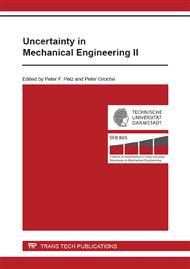[1]
F. Koppka: A contribution to the maximization of productivity and workpiece quality of the reaming process by analyzing its static and dynamic behavior, Shaker Verlag, Aachen (2009).
Google Scholar
[2]
K. Ishikawa: Guide to Quality Control, Asian Productivity Organization, Tokyo (1992).
Google Scholar
[3]
O. Bhattacharryya, S.G. Kapoor, R.E. DeVor: Mechanistic model for the reaming process with emphasis on process faults, International Journal of Machine Tools and Manufacture, 46 (2006), page 836-846.
DOI: 10.1016/j.ijmachtools.2005.07.022
Google Scholar
[4]
O. Bhattacharryya, M.B. Jun, S.G. Kapoor, R.E. DeVor: The effects of process faults and misalignment on the cutting force system and hole quality in reaming, International Journal of Machine Tools and Manufacture, 46 (2006), page 1281-1290.
DOI: 10.1016/j.ijmachtools.2005.11.002
Google Scholar
[5]
T. Hauer: Modellierung der Werkzeugabdrängung beim Reiben – Ableitung von Empfehlungen für die Gestaltung von Mehrschneidenreibahlen (engl. Modeling of tool deflection in reaming – Derivation of recommendations for the design of multi-blade reaming tools), Shaker Verlag, Aachen (2012).
Google Scholar
[6]
E. Pauksch, S. Holsten, M. Linß, R. Tikal: Zerspantechnik (engl. Cutting Technology), Vieweg + Teubner, Wiesbaden (2008).
Google Scholar
[7]
F. Klocke, W. König: Fertigungsverfahren I (engl. Manufacturing Processes 1), Springer-Verlag, Berlin Heidelberg (2011).
Google Scholar
[8]
E. Abele, T. Hauer, M. Haydn, C. Bölling: Reduzierte Unsicherheit bei der Bohrungsfeinbearbeitung - Neue Erkenntnisse zum Vorbohrungseinfluss auf den Reibprozess (engl. Reduced uncertainties during hole-finishing – New knowledge concerning the influence of pre-drilled holes on reaming process), wt Werkstattstechnik online, 101 (2011).
DOI: 10.37544/1436-4980-2011-1-2-81
Google Scholar
[9]
M. Haydn, T. Hauer, E. Abele: Methods for the control of uncertainty in multilevel process chains using the example of drilling/reaming, Applied Mechanics and Materials, 104 (2012), page 103-113.
DOI: 10.4028/www.scientific.net/amm.104.103
Google Scholar
[10]
R. Engelhardt, J. F. Koenen, G. C. Enss, A. Sichau, R. Platz, H. Kloberdanz, H. Birkhofer, H. Hanselka: A model to to categorise uncertainty in load-carrying systems, 1st MMEP International conference on modelling and management processes, Cambridge/UK, 19-20 July 2010, page 53-64.
Google Scholar
[11]
H. Hanselka, R. Platz: Ansätze und Maßnahmen zur Beherrschung von Unsicherheit in lasttragenden Systemen des Maschinenbaus (Approaches and procedures to control uncertainty in load-carrying structures in mechanical engineering), Konstruktion, 11/12 (2010).
Google Scholar
[12]
A. Bretz, S. Calmano, T. Gally, B. Götz, R. Platz und J. Würtenberger: Darstellung passiver, semi-aktiver und aktiver Maßnahmen auf Basis eines Prozessmodells (Representation of passive, semi-active and active systems based on a process model), unreleased paper by the SFB 805 on http: /www. sfb805. tu-darmstadt. de/media/sfb805/f_downloads/150310_AKIII_Definitionen_aktiv-passiv. pdf.
Google Scholar
[13]
K. Risse: Einflüsse von Werkzeugdurchmesser und Schneidkantenverrundung beim Bohren mit Wendelbohrern in Stahl (engl. Influence of tool diameter and cutting edge preparation when drilling steel using twist drills), Shaker Verlag, Aachen (2006).
Google Scholar
[14]
DIN EN ISO 1101: Geometrical Product Specifications (GPS) – Geometrical tolerancing – Tolerances of form, orientation, location and run-out, Beuth Verlag, Berlin (2013).
DOI: 10.3403/30244906
Google Scholar


